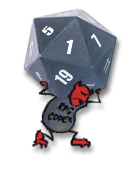EEVIAC
Erudite
Fallout and Tim Cain were featured in "The Vault" section of this months PC Powerplay. I don't have a scanner for the article so I'll just type out some of Tim's quotes.
On Fallout :
On development :
On Fallout not being isometric :
On GURPS :
On SPECIAL :
On Fallout 3 :
Here's the awesome, open-ended experience Bethesda is going to offer up, Tim.
On a related note, they did a similar feature on Arcanum a few months back where Leon revealed that Bloodlines had started out in pre-production as a sequel using the Source engine. It was going to be called "Journey To The Centre Of Arcanum."
On Fallout :
- We set out to make a non-linear game, which today would be called a sandbox game. We wanted the player to make any kind of character and then go off into the wilderness in any direction and still be able to finish the game. Naturally, some characters would be harder to finish the game with than others, but that was our main goal.
We knew we were making a dark game, based on the horrors that 1950's science had predicted for a future apocalyptic world. So we balanced that with humour, by poking fun at those same predictions in a way that would amuse a modern player.
Once we had settled on a post-apocalyptic setting for our world, we debated over all the different types we could choose. I remember debating modern futurism, like alien invasion or cyber warfare, and even the possibillity that there had been no war at all and this was all an illusion or a facade, but in the end, we felt that the Cold War era had the most visceral appeal of all these settings, and most easily opened itself up for humour.
On development :
- In our early design sessions, we all agreed to steer clear of elves and magic, just because we wanted to do something fresh, and also to possibly appeal to people who were tired of, or just not attracted to the fantasy setting. We also really liked The Road Warrior and Mad Max movies that were still pretty recent back then. But in the end it was the adventuring possibilities of a post-nuclear setting that we liked so much.
Most of the development team had played and loved Wasteland. We wanted to make a game that would be just as fun as that one, but with the additional capabilities that modern technology allowed. We wanted to show the gritty realism of a post nuclear future and not just imply it.
On Fallout not being isometric :
- It was a little unusual compared to the other isometric, tile-based engines of the time like X-Com or Crusader. Instead of 45 degrees, we rendered our art to 60 degrees, which meant it was really a cavalier oblique engine than an isometric one. This change let us move the creatures on a hex grid - required by the GURPS system - that would match the wall directions, so it simplified pathing a great deal.
On GURPS :
- At the time I started programming the core isometric engine that would become Fallout, the D&D license was unavailable, or so Interplay thought. So I went after the RPG system that I liked, which was GURPS. At the time I was running a weekly GURPS game, and I thought the system was flexible enough to let me make any kind of RPG setting I wanted. Plus, I had already worked with Steve Jackson Games, who'd let me use the GURPS Space license on some freeware I had written in my spare time. They seemed like a good bunch of people to work with.
After Interplay picked up the D&D license, they almost cancelled Fallout right then so as not to be working on multiple products that would compete with one another. But I pointed out that the setting was so different from orcs and goblins that there would likely be no overlap in the target audience. Marketing believed me, and Fallout was saved from termination.
On SPECIAL :
- Kudos to Jason Suinn for pointing out that the stats could be arranged to form the word SPECIAL. I was calling the system ACELIPS. True story.
I could make all kinds of statements about character construction and ease of use, but really, Chris Taylor and I were deperately trying to make a replacement for GURPS that would work with out existing and completed combat engine. The first round of stats, skills and traits did just that, and Chris's brilliant idea for perks was the icing on the SPECIAL cake.
On Fallout 3 :
- After playing Oblivion, I have high hopes for Fallout 3 being an awesome open-ended experience. Bethesda obviously has good people working there, so I don't want to insult them by offering any advice that might sound like a pronouncement. I just want to play the game like any other fan, which means I will be surprised and delighted by the plot twists and turns and also that I reserve the right to complain about any deviation from the Fallout canon.
Here's the awesome, open-ended experience Bethesda is going to offer up, Tim.
On a related note, they did a similar feature on Arcanum a few months back where Leon revealed that Bloodlines had started out in pre-production as a sequel using the Source engine. It was going to be called "Journey To The Centre Of Arcanum."
















